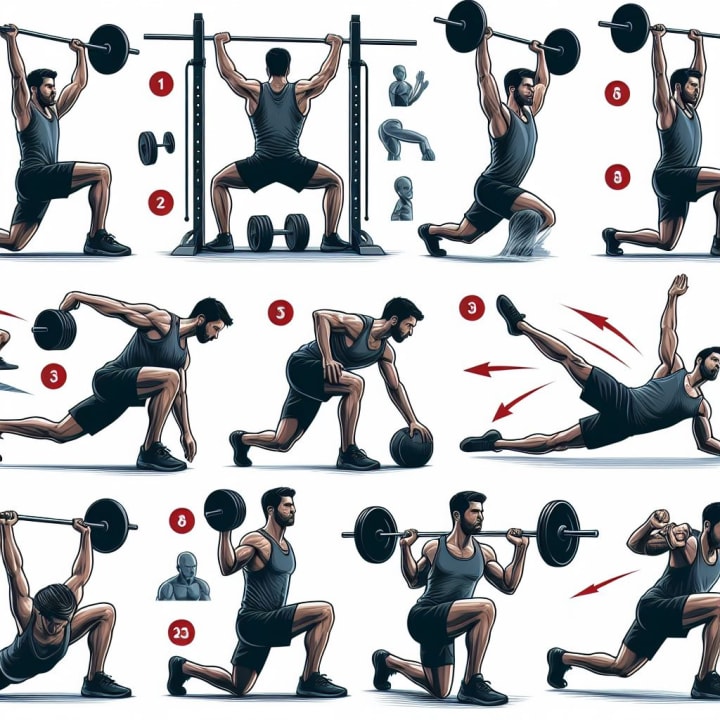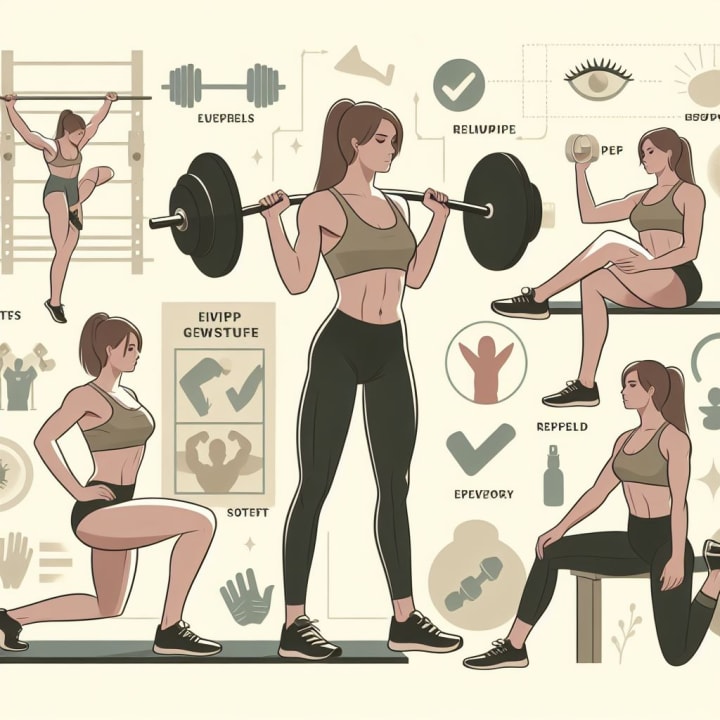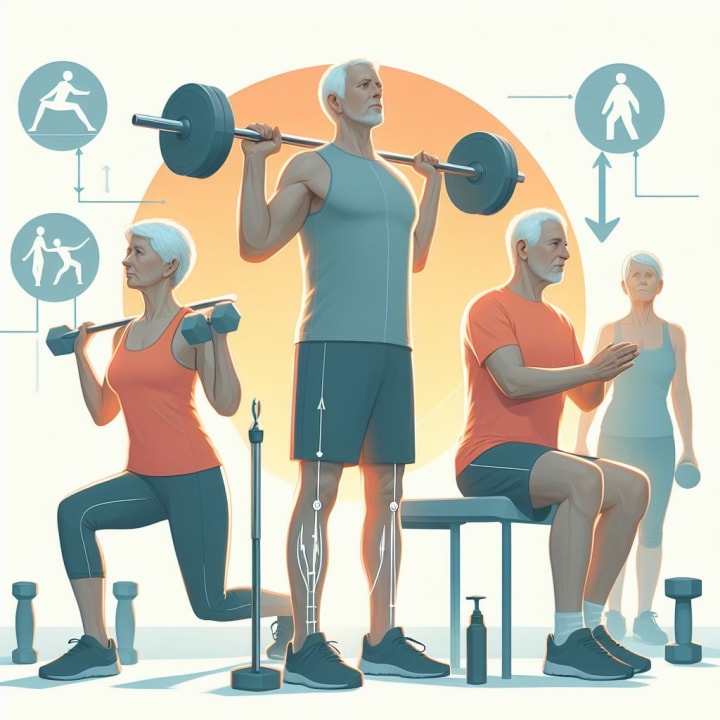Unleash Your Inner Athlete
Building Explosive Power with Dynamic Strength Training

Dynamic strength training is a distinct training method compared to traditional weightlifting. It's designed to cultivate explosive athleticism, speed, and agility . This approach utilizes lighter weights, momentum, and rapid, controlled movements to enhance muscular power, coordination, and quickness.
In contrast to traditional heavy weight training focused on static strength gains, dynamic training prioritizes generating maximum force and rapid muscle contractions to improve athletic performance. This article delves into the world of dynamic strength training, equipping you with the knowledge to incorporate this method effectively into your workout routine.
What is Dynamic Strength Training?
Dynamic strength training involves performing strength exercises with purposeful, continuous motions throughout a full range of motion. The core objective is to refine the ability to exert force swiftly and powerfully. Here are some key characteristics of this training method:
- Lighter to moderate weights are used instead of maximal loads.
- Focus on speed of movement and rapid force production is emphasized.
- Exercises are executed with smooth, explosive movements.
- Full range of motion is crucial throughout each exercise.
- Momentum and acceleration are utilized to increase power output.
- Dynamic start and finish positions are employed instead of static holds.
"The goal isn't just to get strong, but to get strong athletically," explains coach Mike Boyle. "We want to build the foundation for all other athletic attributes like speed, quickness, and agility".
Dynamic strength training cultivates the ability to rapidly access strength for improved performance, making it highly applicable for sports training and functional fitness activities.
Benefits of Dynamic Strength Training

Integrating dynamic strength training into your program offers a multitude of performance and functional benefits:
1. Enhanced Power and Explosiveness
Dynamic training places a strong emphasis on accelerating throughout the entire range of motion. This trains the neuromuscular system to activate and fire muscles rapidly for increased power. Plyometric exercises, such as jumps and medicine ball slams, are particularly effective for developing explosive strength throughout the whole body by rapidly stretching and contracting muscles.
2. Improved Athletic Performance
The strength developed through dynamic training directly translates to athletic activities, resulting in faster and more powerful movements. Studies have shown that dynamic strength training can enhance:
• Sprint speed
• Vertical jump height
• Agility for quick changes in direction
• Throwing velocity
• Acceleration for field sports
By optimizing strength for speed and power, dynamic training elevates overall athletic ability .
3. Increased Movement Skills
The constant acceleration through a full range of motion necessitates enhanced motor control and coordination. Dynamic strength exercises improve proprioceptive skills, which are critical for athletic movements. The smooth, controlled motion also improves mobility by taking the joints through their complete functional range. The dynamic nature fosters healthy movement patterns to reduce the risk of injuries.
4. Boosted Muscular Endurance
Lower weights and higher repetition ranges train muscles for endurance. The fast tempo and shorter rest periods also contribute to increasing the work capacity of the muscles and cardiovascular system.
5. Reduced Risk of Injuries
Safely managing momentum teaches control throughout the entire motion. This enhances stability and strengthens tendons and ligaments, helping to prevent injuries. The focus on acceleration avoids the accentuated deceleration of traditional strength training, which can increase shear forces. The dynamic nature also improves mobility to promote joint health. For all these reasons, dynamic strength training reduces injury risk and reinforces durable athletic movements.
6. Functional Strength Development
Dynamic training aims to develop strength that directly translates into improved performance. This functional fitness approach is highly specific to athletic needs. Coach Charles Poliquin observes, "Dynamic effort training produces strength gains in precisely the ranges required by the majority of sports movements". The dynamic approach cultivates whole-body power optimized for real-world athletics and active lifestyles.
Examples of Dynamic Strength Training Exercises

Many traditional strength training exercises can be modified to incorporate a dynamic and explosive element. Here are some excellent options to consider:
• Power Cleans: A traditional exercise transformed into a dynamic movement by explosively lifting the barbell from the hang position to shoulder height in one continuous, fluid motion. This exercise emphasizes triple extension of the ankles, knees, and hips for full-body power development. Lighter weights allow for greater bar speed and acceleration. You can find a detailed guide to power cleans on websites like.
• Broad Jumps: Powerful jumps forward for maximum distance with a focus on explosive take-off and soft landing [4]. Maintain minimal pause between jumps to sustain constant dynamism and muscular loading. Broad jumps are a fantastic way to train high-velocity concentric contractions for increased lower body explosiveness.
- Clap Push-Ups: Take the standard push-up a step further by exploding upwards with enough force to momentarily come off the ground and clap your hands together before lowering yourself back down in a controlled manner. This variation adds an explosive element.
• Box Jumps: Explode upwards to jump on a box, aiming for maximum height with a soft landing. Maintain minimal pause between jumps to sustain constant exertion and muscular loading. Box jumps are a fantastic way to train lower body power.
• Medicine Ball Slams: In a two-handed motion, throw a medicine ball overhead with maximal force into the ground, controlling the ball on the bounce back. This full-body exercise works major muscle groups through a powerful movement that develops explosive power.
• Band-Resisted Sprints: Sprint while dragging against the resistance of elastic bands held by a training partner. This exercise overloads the hip extensors through a full sprinting range of motion, enhancing high-velocity strength and acceleration.
• Plyometric Lunges: Perform lunges with an explosive jump between each rep, switching legs in mid-air. This exercise effectively stretches and contracts muscles, building power throughout the lower body.
• Speed Deadlifts: Execute a traditional deadlift with lighter weight, using a faster tempo and maintaining constant tension to focus on power development. This variation strengthens the posterior chain muscles through a dynamic hip hinge movement.
These are just a few examples. Include a variety in your workouts to target different muscle groups and develop well-rounded athleticism.
Programming Dynamic Strength Training

To maximize your gains in power, speed, and quickness, follow these programming principles:
1. Train Explosively:
Focus on speed and power: Lift the weight as quickly and explosively as possible through the entire range of motion, maintaining constant acceleration.
Power through speed: Adjust the weight to allow for maximal bar speed.
Lighter loads: Use lighter weights (around 30-70% of your 1RM) to avoid a deceleration phase during the lift, optimizing power output.
2. Full Range of Motion (ROM):
Complete each rep through the full range of motion of the joint. Power is generated by maximizing the length range through which the muscles contract.
Rest Periods:
Allow adequate rest (1-3 minutes) between sets to ensure sufficient recovery for subsequent explosive efforts. Shorter rest periods can be used to focus on conditioning.
Gradual Progression:
Begin with basic exercises using just bodyweight or minimal resistance. Gradually build up the intensity over time.
Increase weight, sets, reps, and exercise difficulty progressively as your movement competency improves.
Volume:
Perform 3-6 sets of 3-6 repetitions for each exercise to maximize power and speed development. This rep range hits the ideal zone for dynamic strength training without causing excessive fatigue.
3. Technique:
Maintain perfect form and control throughout the movement. Never sacrifice proper technique for additional weight or speed. Flawless technique ensures safety and maximizes results.
Periodization:
Design your program with a strategic variation in volume, intensity, and recovery to develop athletic power over time. Plan your training to peak at the right moments in your season or goals.
Sample Dynamic Strength Workout
Here's a sample dynamic lower body workout designed to build athletic power:
Warm-up:
5 minutes stationary bike
Leg swings (10 reps per leg)
Walking lunges (20 steps)
Workout:
Box jumps: 4 sets x 5 reps
Split squat jumps: 4 sets x 6 reps per leg
Power cleans: 4 sets x 3 reps
Single leg deadlifts: 3 sets x 8 reps per leg
Cool-down:
Light jogging (5 minutes)
Static stretches (hold each major muscle group for 30 seconds)
This workout focuses on training major leg muscles through their full range of motion with explosive contractions. Gradually increase the weight and volume over time. Keep your workouts short and intense.
Supplemental Exercises
Complement your dynamic strength training with these additional exercises:
1. Plyometrics: Bounding, hopping, and depth jumps improve power and elasticity.
2. Sprints: Short bursts (5-40 yards) develop high velocity running strength.
3. Agility Drills: Ladder drills, cone jumps, and lateral shuffles enhance multifaceted quickness.
4. Strongman exercises: Pushing or dragging heavy sleds and implements builds real-world power.
5. Weightlifting: Squats, deadlifts, and presses increase baseline strength.
Combine exercises that train strength through both low and high-velocity contractions to develop a well-rounded spectrum of speed-strength.
Training Considerations for Women

Dynamic strength training offers significant functional benefits for women. However, due to hormonal differences, women's training programs may require some adjustments:
1. Lighter Weights: Prioritize speed of movement over heavy loads. Use weights that allow for optimal acceleration to maximize power gains.
2. Higher Repetitions: Aim for 10-15 reps per set to induce metabolic stress and improve muscular endurance.
3. Single-Leg Work: Incorporate single-leg exercises to develop lower body power while promoting balance and stability.
4. Upper Body Training: Include pushing and pulling exercises to build a strong and athletic torso.
5. Plyometrics: Plyometric jumps are safe and effective for women when performed with proper technique.
6. Recovery: Schedule more recovery time between intense training sessions to allow for optimal muscular adaptation.
With personalized programming, women can achieve significant performance improvements through intelligent dynamic strength training.
Dynamic Warm-Up Exercises
A dynamic warm-up is crucial before dynamic strength training to activate muscles and enhance range of motion. Here are some effective examples:
1. Lateral Lunge Walks: Take large side lunges while walking to engage glutes and inner thighs.
2. Backward Sprint: Perform light backward running to improve hip flexor mobility.
3. Inchworms: Progressively walk your hands down a wall while lowering your hips to stretch hamstrings and shoulders.
4. Spiderman Stretch: Assume a crawling position and dynamically reach your hand and knee towards each other on the same side.
5. Forbidden Walk: Move laterally with small steps while keeping your hips low to improve hip mobility in the transverse plane.
6. Scorpions: Rotate your torso with one arm reaching overhead while keeping the opposite leg extended for core activation.
Complete 10-15 repetitions of 8-10 drills to prepare your body for dynamic strength training.
Modifications for Beginners
Beginners should take a gradual approach to dynamic strength training:
1. Bodyweight Exercises: Start with exercises like air squats, push-ups, and lunges using only your bodyweight.
2. Low-Impact Plyometrics: Begin with low-impact plyometrics such as skipping, lateral hops, and box step-ups before progressing to more demanding jumps.
3. Light Resistance: Use light resistance bands, suspension trainers, or dumbbells to add load while maintaining proper form.
4. Higher Reps and More Rest: Perform sets of 12-15 repetitions with extended rest periods (2-3 minutes) to allow for sufficient recovery and focus on technique.
5. Reduced Sets and Slower Tempo: Start with fewer sets (2-3) and perform exercises with a slower tempo to prioritize control and range of motion over speed.
6. Master the Basics: Focus on mastering simple movements before progressing to more complex multi-joint exercises.
Building a solid foundation in neuromuscular control is essential before introducing higher-intensity dynamic training.
Modifications for Seniors

Older adults can benefit from dynamic strength training when implemented with appropriate modifications:
1. Lightest Weights and Minimal Plyometrics: Use minimal weight and avoid exercises with high-impact plyometric jumps to minimize stress on joints.
2. Slower Rep Speed: Lengthen the rep duration to 3-4 seconds, focusing on time under tension rather than speed of movement.
3. Unilateral Exercises: Include single-leg exercises to improve leg stability and balance.
4. Increased Recovery Time: Allow more rest time between sets to ensure adequate recovery.
5. Reduced Volume: Decrease the overall training volume to avoid overexertion.
6. Seated Exercises: If balance is a concern, perform exercises while seated.
7. Eccentric Strength Training: Focus on the eccentric (muscle lengthening) phase of exercises to improve injury resilience.
By following these modifications, seniors can safely experience the benefits of dynamic strength training and enhance mobility, function, and vitality.
Conclusion
Dynamic strength training can be a valuable tool to add to almost any workout program. This training method ignites significant improvements in power output, movement skills, muscle elasticity, and high-velocity capabilities.
FAQs:
- Dynamic vs. Powerlifting? Powerlifting focuses on lifting the most weight possible with slow, controlled movements. Dynamic training uses lighter weights with faster motions to build power and speed.
- Mixing Dynamic and Heavy Lifting? Yes, you can combine these for a well-rounded approach. Just listen to your body and take rest days in between.
- Good for Runners and Cyclists? Absolutely! Dynamic training helps you move with more power and use less energy, making you a better endurance athlete. Just don't overdo it on the strength training.
- How Fast Will I See Results? You can expect to get faster, stronger, and more explosive within a month or two with a good program. Aim for at least 3 months to really maximize your gains, and stick with it!
- Daily Dynamic Training? Nope, your body needs time to recover from the intensity. Do dynamic training 2-4 times a week, with at least a day and a half rest in between.
Disclaimer: This article is for informational and educational purposes only. It is not intended to provide medical advice or to diagnose, treat, cure, or prevent any disease. You should always consult your doctor before taking any supplement or drug, especially if you have any medical conditions or take any medications. You should also do your own research and verify the information and claims made in this article. We are not responsible for any adverse effects or consequences that may result from using any of the products or information mentioned in this article. Use at your own risk and discretion.
About the Creator
LORD LIFESTYLE
Immersed in the elite essence of life, LORD LIFESTYLE is your beacon for authentic living. We offer science-based picks & treasures to elevate your world. Dive into our blogs for curated wisdom & products that enrich every facet of life.
Enjoyed the story? Support the Creator.
Subscribe for free to receive all their stories in your feed. You could also pledge your support or give them a one-off tip, letting them know you appreciate their work.






Comments
There are no comments for this story
Be the first to respond and start the conversation.